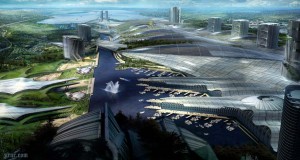The visualisation shown is by conceptual artist Mark Goerner. It would be interesting to surmise what premises might underlie this vision of a possible ‘future’ city? Although Mark is neither an architect or a landscape architect he has produced a vision of a probable reality that both architects and landscape architects can recognise and respond to.
I sent this picture to Tom after realizing I had confused the terms ‘aspect’ and ‘prospect’ in my previous comments [see where is this landscape?]. Tom sent through links to Repton’s discussion of aspect and prospect and Loudon’s response.
Perhaps the oversight (in not first checking terms) leading to this discussion is more valuable than I first realised. It is unfortuneately relatively common in architecture to deal with issues of sustainability by modifying climatic effects using techonology (green or otherwise), often without first having planned the use, proximity and orientation of spaces in an iterative manner. [In this discussion also no regard has been given to topographic (and other) concerns ie. founding materials, volumes and degree of incline etc on the arrangement of space.] This way of proceeding, if Repton’s comments are anything to go by, is hardly new. And, if Loudon’s response is correct (and I believe it is), this oversight is a constant source of chargin to architect’s who seek to optimise (the positive) and minimise (the negative) by design.
Prospect is an essential part of the visual experience of a building from the interior; as much as it is an essential part of the visual setting (perhaps approach…but not always) of a building. Aspect is essential to the bodily experience of a building from the interior; as much as it contributes to how the building and landscape meld in harmony to form a composite at a myriad of viewpoints and scales.
Where might this city most probably be located? Why is it situated and arranged in the way that it is? What is the relationship of built form to landscape? What sort of a place would it be to live in? Is it a sustainable city?

